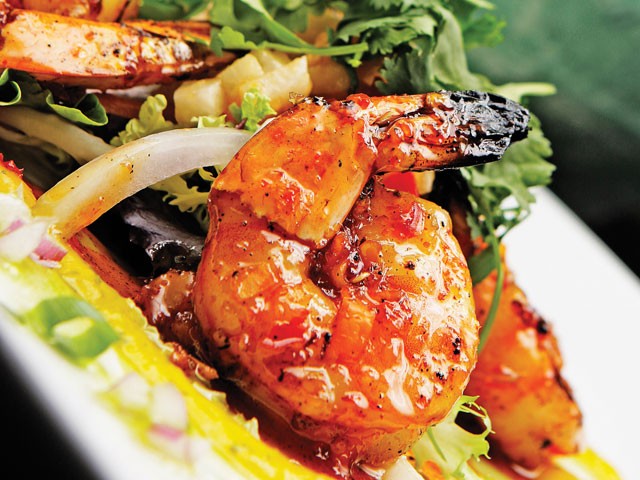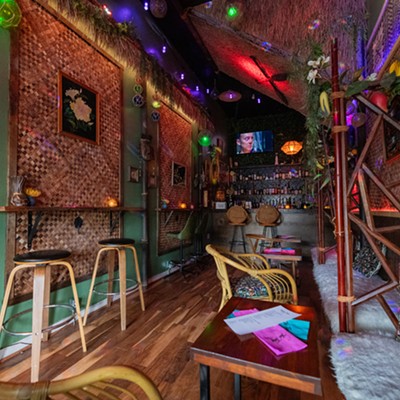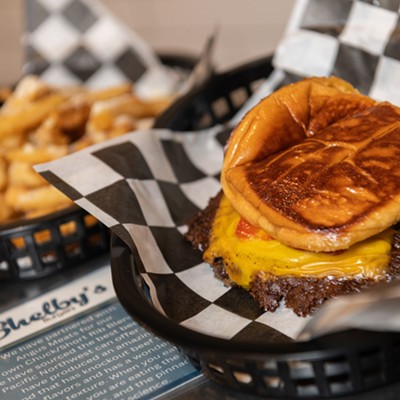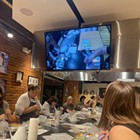THE SMALL PLATE APPROACH
Spokane is a conservative food town. Collectively, we don’t cotton to new culinary trends just because the critics in NYC or San Francisco are swooning over cooking sous vide or edible foams. Given this, it isn’t all that surprising that Jerry Schraeder’s small-plate-only spot, Twelve28 Tapas, is now history. Yet the idea he pursued exclusively in 2007 has worked its way onto nearly every high-end menu around town where smaller portions of thoughtfully prepared dishes are offered at prices that encourage both experimentation and sharing. Sure, we still have more than our fair share of belly-up-to-the-bar buffets, but check out the first plate or appetizer selections at Wild Sage, Santé, Agave Latin Bistro or the Davenport’s Safari Room (to name just a few) and see if you don’t agree. (KEVIN FINCH)
LOCAVORES
Hey, what’s that on my plate? No longer content to eat genetically engineered food that has been polished, shrink-wrapped and shipped halfway around the globe, we’re starting to ask questions about where our food comes from. Michael Pollan’s 2006 book The Omnivore’s Dilemma brought concerns about industrial farming to a broader audience than before.
In order to gain more control over the quality of what we’re eating, how it impacts those who produce it and the environment, we’re becoming more focused on local food. We’ve seen a renewed interest in gardening (even the White House is on board), farmers markets are on the rise and the number of restaurants sourcing local ingredients has increased. “Santé’s goal this year is to spend more time with local farmers and build relationships,” says the restaurant’s chef/owner Jeremy Hansen.
Opening soon, Spokane’s Main Market will be another venue for consumers to buy local, get to know the farmers and engage in dialogue about what we’re putting in our bodies. What remains to be seen is whether we’ll embrace the locavore movement where it really counts: with our pocketbooks. (KIRSTEN HARRINGTON)
NEIGHBORHOOD DINING
As with many of our trends across the board, neighborhood dining wasn’t invented in the Oughts. Especially in the late innings, though, it began to explode. William Bond, owner of Luna, says that when he and wife Marcia started their restaurant in the mid-’90s, they were the third restaurant on the South Hill, after a place in the current location of Ginger and an Italian joint in what now houses the Two Seven. There may have been one or two more, but here’s the point: The areas around Luna (57 th and Regal area) and Ginger (Grand near 14 th ) both have dense clusters of restaurants. There’s great ethnic and world cuisine to be had near the 1800 block of East Sprague. Some of the best food in Spokane can be found in Browne’s Addition, and Perry Street is fi nally seeing its revitalization translate into excellent eating and drinking options. Even near north, in the still spotty West Central neighborhood, we’re looking forward to places like the Local Pub drawing more than just the courthouse set. (LUKE BAUMGARTEN)
FOOD PORN
The Food Network has been around since 1993, but it wasn’t until the Oughts that the growing obsession with food personalities (and the more dubiously used term, celebrity chefs) brought the Rachel Rays and Bobby Flays of the world into the spotlight. It’s something of a chicken-egg phenomenon — the kind of thing social scientists could debate for another decade — but something happened at the turn of the millennium to take food television from one channel on the dial to a national obsession. For years, Emeril Lagasse and Wolfgang Puck were about the only ones. Then, in 2004, we watched some guy named Rocco DiSpirito’s entire career implode on national television.
Credit food-porn, and the growing need for new reality show fodder, and maybe even the growing mindfulness about from where our food comes and how it is prepared (if we’re being generous with our motives), but it was a banner decade for gustatory voyeurism.
And it looks to continue. With Top Chef roaring, Gordon Ramsey clocking two different shows and Rachel Ray the only celeb we can think of with a diverse-enough media portfolio (TV, books, a magazine) to replace Oprah as the queen of all media when the Grande Dame retires, it’s safe to say that the Oughts made the culinary arts the oeuvre that everyone seems to care about (watching on TV). (LB)
COFFEE SPECIALIZATION
Wine snobs have been around for centuries, and coffee snobs for decades. The Oughts, though, brought a new refi nement or pretentiousness (depending on your perspective) to coffee afi cionados.
You may be one. Or you know one: folks who sneer at the masses cued up in the Starbucks drive-through and secretly believe Howard Schultz may be the Antichrist for over-roasting his beans. They wax eloquent about coffee brewed in an $11,000 machine (the Clover) and can tell you about the benefi ts of different roasting techniques. Locally, they are on a fi rst-name basis with Simon (Craven’s Coffee) or Tom (Thomas Hammer) or the folks at Doma or Four Seasons. Or they make trips to Seattle and come back with Caffé Vita contraband in their trunk. Ask them what fl avors they most appreciate in their coffee, and be prepared for an enthusiastic answer that includes descriptors like “green apple, caramel, blackberry, red currant and creamy.”In the last half of the Oughts, coffee snobbery in towns like Seattle went from specifics like roast and country of origin to become hyper-specific — blends that came from single-origin sources: single farms or specific plots of land. Locally, Thomas Hammer just brought out its first single-farm-sourced blend in 2009. If that catches on, “single-origin” is all you’ll be hearing about through 2012. (KF)
WASHINGTON WINES
The 2008 movie Bottle Shock chronicled the 1970s story of an upstart winery in Napa Valley that entered a wine competition and besting a number of previously unbeatable French wineries. If the ’70s showed the remarkable sophistication and daring of New World wines, the Oughts belonged to Northwest vintners. Wine in Washington has exploded. In the last decade, the state became the second-largest producer of wine in the country, with more than 36,000 acres under cultivation. In part, this reflects our ideal geography for producing not just quantity but quality: premium grapes that produce strong vintages year after year. Washington growers focus on Riesling, chardonnay, cabernet sauvignon, merlot and syrah, but more than 25 other varietals are grown. Add to this diversity the record-breaking wine harvest of 2008 (145,000 tons), and we might see a bottle from a local winery bringing home top marks before another 10 years pass. (KF)
FOOD TRUCKS
Mix equal parts coffee kiosk, hotdog cart and drive-thru fast food, and whaddya get? Mobile food service units, affectionately known as roach coaches, selling everything from tamales to teriyaki.
For some vendors, it’s a pit stop on their way to becoming permanent establishments, like Joel’s in Sandpoint or Tacos Tumbras in Spokane, which now has two brick-and-mortar locations. For others, it’s the ultimate American dream: Own your own business and take it with you wherever you go. Catering to our car-oriented culture, food trucks account for nearly 10 percent of a $566 billion industry, according to the National Restaurant Association.
They’re even bigger in towns like Portland — and with their popularity, relatively low overhead and the increasing difficulty of getting small business loans, expect more aspiring food entrepreneurs to take this route. (CARRIE SCOZZARO)
CRAFT BOOZE
When the economy is in the tank, people, somewhat poetically, tend to get tanked, too. Good thing this was a great decade for craft breweries, otherwise our out-of-work and under-employed would be swilling nothing but macrobrews.
In North Idaho, check out Wallace Brewing (Wallace), Laughing Dog (Ponderay), MickDuff’s (Sandpoint) and Coeur d’Alene Brewing (formerly T.W. Fishers), now affiliated with Spokane’s Steam Plant Grill.
In Washington: Northern Lights Brewery (Spokane) and the new Golden Hills Brewery (Airway Heights).
The growing trend is hard alcohol distilleries. Boise-based Bardenay, the first restaurant in America to house its own distillery, has a branch in Coeur d’Alene. Washington’s first craft distillery since Prohibition is Spokane’s Dry Fly. In the two years since Dry Fly opened and subsequently lobbied Olympia for a craft distillery license classification, five more craft distilleries have opened up, and 13 more await licenses.
While other businesses are dealing with recession fatigue, Dry Fly can’t keep its product on shelves. The state of Washington recently relaxed regulations on craft distilleries, so look for 2010 and beyond to be the decade of (legal) rotgut. (CS)
DEMONIZATION OF BOTTLED WATER
You had a good run, bottled water, a run that saw your popularity rise through the ’80s and ’90s until you went from being the hydrant of kings to the drink of the common man. “$1.99 for a liter?!” we shrieked. “That’s practically cheaper than the tap! And cleaner! Right?” But the Oughts weren’t so good to you, bottled water, because we discovered how good you weren’t to us.
The environmental impact was staggering and the water — turns out — often isn’t much more than tap bottled at altitude. Or in the case of Aquafina and other massive brands, purified municipal water.
In the Oughts, celebrity chefs like Mario Batali bolted in favor of faucet water and then, in June 2008, the U.S. Conference of Mayors voted to recommend that city halls across the country not even use bottled water for special events. In August 2009, Nestlé, America’s biggest water brand, announced earnings losses for the first time in six years (due to sluggish sales in the U.S. and western Europe).
There’s still plenty of big money to be made in shipping branded water to all corners of the globe, and usage continues to rise worldwide, but among the set who popularized it, bottled water is so gauche. (LB)
KITCHENS WITH MISSIONS
Who knew your morning latte would change so many lives? We’ve seen a rise in the number of food establishments with a social purpose. Spokane’s New Leaf Café and the Taste and See tearoom both train women in transition for jobs in food service, nourishing them body and soul. Christ Kitchen provides hope for women in poverty, with its gourmet food-product and catering business. The Service Station is a fully vertical, Godcentric, coffee production process. With fields in Kenya, they’re evangelizing the good Joe around the world. The much-ballyhooed One World community kitchen allows customers to choose their portions and their price, down to volunteering in trade for a meal. Now that’s something to sink your teeth into.
It’s hard to know if this trend will continue, but of all the above, we think this one should. (KH)

















